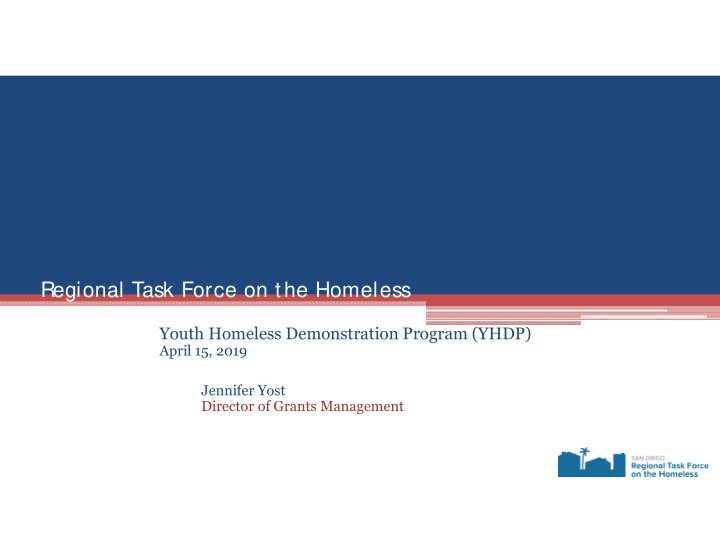



Regional Task Force on the Homeless Youth Homeless Demonstration Program (YHDP) April 15, 2019 Jennifer Yost Director of Grants Management
YHDP Overview • Purpose: Initiative designed to reduce the number of youth experiencing homelessness. Serve youth in households where no one is over the age of 24, including unaccompanied youth (14-17 yo), pregnant, and parenting youth. • HUD - $7.94 million over 2 years • All applicants will be subrecipients of RTFH • May be renewed under the Continuum of Care (CoC) Program
Coordination • Coordination of Effort across the system ▫ Plan, Discuss and Decide collectively ▫ Apply Seperately • Inclusion of MOU/Letter that lists ▫ Each agencies component ▫ How it works together
YHDP Eligible Activities • Youth System Navigators • Prevention/Diversion • Crisis Response Host Homes Model • Flexible Non-Time Limited Housing ▫ Joint - Transitional Housing/RRH ▫ Joint – RRH/Permanent Housing ▫ RRH ▫ Permanent Housing Page 84-88 of the CCP
YHDP Requirements • 25% Match • Compliance with HUD CoC Regulations & Requirements ▫ Housing First ▫ HMIS ▫ CES Participation • Compliance with Local Requirements ▫ Quarterly Reporting in ZoomGrants ▫ Participate in Training and Learning Collaboratives
Multiple Applications • One program per application • Unlimited number of applications • ZoomGrants allows you to create a duplicate application ▫ Create first application and fill out with all the information that will be the same in each application ▫ Create duplicates and customize each application
You can create duplicates of any application, even those that have already been Duplicate Applications
S ubrecipient vs Contractor • Subrecipients may exercise discretion in making program decisions and carrying out program activities, while contractors cannot. • Contractors are responsible for complying only with those requirements and conducting those activities that the recipient or subrecipent specifies in their contracts.
S ubrecipient Characteristics • Makes determinations about who is eligible to receive what assistance; • Has its performance measured in relation to whether objectives of the program were met (e.g. is accountable for meeting HUD-established performance measures); • Has responsibility for programmatic decision making; • Is responsible for adherence to applicable requirements in the program regulations and HUD’s grant agreement with the recipient; and • Uses the program funds to carry out a portion of a subrecipients’s program for a public purpose specified in the McKinney-Vento Homeless Assistance Act (e.g. the benefit of homeless individuals and families and individuals and families at risk of homelessness), as opposed to providing goods or services for the benefit of the subrecipient.
Contractor Characteristics • Provides the goods and services within normal business operations; • Provides similar goods or services to many different purchasers; • Operates in a competitive environment; • Provides goods or services that are ancillary to the operation of the HUD funded programs; and • Is held to the terms of the contract rather than the compliance requirements of the HUD funded programs.
Example 1: Rental Assistance • A contractor– organization’s sole responsibility is to write and mail rent checks to landlords for program participants on whose behalf rental assistance is paid under the HUD Funded Program. • A subrecipient– operating a Rapid Re-housing project on behalf of the recipient (RTFH) and the recipient provides the subrecipient with the authority to make decisions about items such as: project design; eligibility requirements for the project; conducting its own intakes and assessments; and writing its own rent checks to landlords or contracting out for that service.
Example 2: Legal S ervices • A contractor– organization provides limited legal services only to those program participants designated to receive legal services by the emergency shelter provider. • A subrecipient– organization: identifies its own program participants; completes its own intake and assessment of program participants; and determines and carries out the legal services it believes are required by the program participant.
Example 3: Prevention Program • A contractor– organization provides limited prevention services only to those program participants designated to receive eviction prevention services by the homeless service provider. • A subrecipient– organization: identifies its own program participants; completes its own intake and assessment of program participants; and determines and carries out the prevention activity it believes are required by the program participant.
RTFH Website for YHDP
YHDP Timeline/Next Steps • April 16: RFP opens (30 Days) ▫ Applications submitted through ZoomGrants ▫ FAQ: Periodic Posting to Webpage and Announced within ZoomGrants ▫ April 15-May 3: Office Hours with HUD TA on different Housing Models (no RFP Questions will be taken) ▫ May 10: FAQ Closes – no further questions will be answered • May 16: Applications Due • May/June: Applications Rating and Ranking • June 20: Recommendations presented to CoC Board • July 1: Projects submitted to HUD
Questions & Discussion Questions?
Contact Info: Jennifer Yost Director of Grants Management Jennifer.Yost@rtfhsd.org (858) 292-7627 x 15 YHDP RFP Questions Youth@rtfhsd.org
Recommend
More recommend